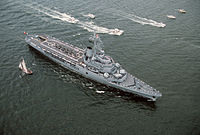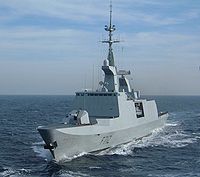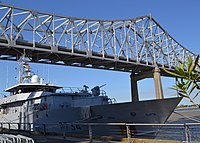Talaharan Navy Corps
| TCDF Navy Corps | |
|---|---|
| ⵛⴰⵛⵀⴰⵜ ⵏ'ⵀⴰⵔⴱⴰⵎⴰⵏ Šašhat N'Harbaman | |
 Roundel of the Talaharan Navy Corps | |
| Active | Since 1845 |
| Country | |
| Type | Navy |
| Role | Naval warfare |
| Size | 43 ships 14,990 personnel |
| Part of | Talaharan Commune Defense Forces |
| Colours | Black Red White |
| Engagements | List
|
| Commanders | |
| Commander-in-Chief | Executive Council |
| Executor of Defense | Taos Jebar |
| Defense Committee Senior Representative | Admiral Iken Meduran |
| Defense Committee Elected Representative | Watch Sergeant-Major Yimlul Aderfi |
| Insignia | |
| Naval jack | |
| Naval ensign | |
| Civil/merchant ensign | |
| Roundel | |
The Talaharan Navy Corp, (Takelat: Šašhat N'Harbaman N'Talahara; ⵛⴰⵛⵀⴰⵜ ⵏ'ⵀⴰⵔⴱⴰⵎⴰⵏ ⵏ'ⵜⴰlⴰⵀⴰⵔⴰ), officially the Talaharan Commune Defense Forces Navy Corps, is the oldest and smallest branch of the Talaharan Commune Defense Forces. Dedicated to the protection of Talahara's coastline, the TCDF Navy Corps has a fleet of 43 ships, including 23 major surface combatants. The ships and administrative offices of the Navy Corps are staffed by just under 15,000 personnel. The senior representative of the Air Corps at the Defense Committee is Admiral Iken Meduran, while Watch Sergeant-Major Yimlul Aderfi holds the enlisted seat.
The Navy Corps was founded in 1845 as the Talaharan Navy; the first professional military body in the Talaharan Commune. Renamed to the Talaharan Navy Corps in 1853, it became part of the unified armed forces in 1854 with the inception of the Talaharan Army Corps. The Navy Corps has taken part in every military engagement involving the Commune excepting the Annexation of Amara in 1919. Until the Gran Aligonian crisis, the TCDF Navy Corps and the Tyreseian Workers' Naval Fleet jointly operated a naval base on the Aligonian island of Porta Mobria.
At present, the Navy Corps is a relatively modest force with an aging inventory, though its equipment remains relevant due to modernization efforts. The fleet coordinates closely with the Tyreseian Workers' Naval Fleet, going on manoeuvres and patrols together along the Rubric Coast.
History
During the Talaharan Civil War, the Communard forces did not operate a dedicated navy. Constitutional Republican vessels were seized on occasion after boarding actions, but would generally proceed to operate as independent vessels in the fashion of Black Guard units at the time. After the conclusion of the war, it became apparent that irregular ships would not be able to effectively guard the Commune's coasts. Despite this, the creation of a new navy was deadlocked first by the drafting of a constitution and subsequently by political disagreement over the professionalization of the military. The issue became an electoral one, and with affiliates of the Communal Security salon flooding into the Supreme Legislative Council, the Talaharan Navy was officially founded in 1845.
The early Talaharan Navy appropriated the assets of naval Black Guard units and united them under a single fleet command, based in Takalt. The Navy also set about establishing manufacturing and procurement of military-grade vessels and equipment. Despite being professionalized, the early era of the Navy was chaotic. Individual ships maintained a great degree of independence. Crews elected captains and captains elected commodores to command squadrons, but there were effectively no regulations to compel an independent vessel to act in cohesion.
In addition to preparing for the inception of a professional land warfare branch in 1854, the 1853 reorganization of the Talaharan Navy into the Talaharan Navy Corps established the modern hierarchical structure of the branch, something that was anathema to the communalist sensibilities of the political opposition of the day. A year later, the TCDF was officially introduced with democratic controls over advancement and representation at the new Defense Committee. This compromise between democracy and hierarchy proved to be stable enough for the purposes of the Navy Corps and its political repercussions.
The Navy Corps was initially slow to adopt new technologies. The first successful Talaharan ironclad-type ship was launched in 1879. Despite lacking a formal developmental alliance, growing ties with the now-syndicalist Workers' Federation of Tyreseia provided a major boost to Talahara's shipbuilding and development sectors. Following the Tyreseian naval doctrine, Talahara built two of its own armoured cruisers and a dreadnought-type by 1912. In 1919, Talahara launched its first major offensive action on another nation, seizing the Amara region from south-eastern Yisrael. The Navy Corps did not take part in the operation but remained on standby to counter any reprisal.
Talaharan naval development stagnated again through the rest of the 1910s and the 1920s. With the formation of the Joint Development Agreement in 1933, Talaharan and Tyreseian design bureaus officially combined resources, though the weight of innovation fell clearly on the Tyreseians. For their part, Talahara remained an important customer and contributed to the testing and evaluation of different designs. With the relatively closed nature of the Periclean Sea, neither Talahara nor Tyreseia developed carrier-based doctrine, continuing to rely on capital ships through the first half of the 20th century.
The Social War, in which Tyreseia covertly donated a cruiser and sent volunteers, provided lessons on how warfare had changed and the necessity of airpower to complement naval engagements. The 1951 Liberation of Kirthan was Talahara's first truly combined arms operation. Talaharan troop landings were assisted in large part by air superiority and scouting for landing positions on the relatively demilitarized coastline. Despite this success, it was apparent that Talaharan battleships were rapidly becoming obsolete.
The second half of the 20th century saw the Rubric Coast's vessels shrink in size and adapt to missile-based warfare. Tyreseia also launched their first nuclear-powered test vessel. The two Mass Akli-class helicopter cruisers were Talahara's first foray in naval aviation, and so far the only. Both the Mass Akli and the Fatma Tamara have been maintained in service and updated over their service life, but carry small missile payloads for their size and have an antiquated arrangement of four guns. Battleships and battlecruisers also gave way to the development of destroyers and frigates specializing in anti-air, anti-submarine warfare, and missile weaponry.
The modern Talaharan Navy Corps is the smallest of the three branches, with land and air projection having greater primacy in Talaharan military doctrine. Despite this, the Navy Corps is capable of fulfilling its intended mission of littoral defense, particularly in coordination with the Tyreseian fleet. In recent times, Talahara's naval interests have been frustrated by political crises in Gran Aligonia and heightened tensions with regional rivals. This, in combination with the aging fleet, has led to calls for increased naval development and an expansion of the service.
Structure and organization
Talaharan vessels are based out of three naval bases on Talahara's coastline; Maktarim, Takalt, and Kirthan. Talaharan vessels may also be based out of Tyreseian bases for extended operations. Prior to 2019, Talahara also had a naval base on the Aligonian island of Porta Mobria that was jointly leased with Tyreseia. Following civil unrest, the government of Gran Aligonia terminated its leasing contracts for both the Talaharan-Tyreseian base and a Latin base on the isles and foreign fleets were forced to vacate.
The TCDF Navy Corps Admiralty is officially based aboard the fleet's flagship, the Mass Akli. The Mass Akli is primarily based out of the Tiɣraman Naval Base in Maktarim. It is rarely sent out on manoeuvres at present but is frequently used as a training ship. In practice, the Admiralty operates out of the offices of the Tiɣraman base.
The Talaharan Navy Corps also has no permanent ship groupings, but doctrinally has two formations based around its helicopter cruisers. Each cruiser has an escort of two destroyers and further support from frigates and smaller vessels, including corvettes. These formations are referred to as Cruiser Groups. Squadrons based on a pair of destroyers with frigate escorts are still referred to as Cruiser Groups, even if no cruiser is included. Auxiliary vessels and smaller surface combatants such as patrol ships are organized into ad hoc groups, typically Patrol Squadrons. The Navy Corps's four submarines are also typically grouped together into a Submarine Squadron but can be broken off into pairs or individual units for specific missions.
Equipment
Major surface combatants
| Class | Image | Type | Displacement (tonnes, standard) |
Armament | Vessels | Notes |
|---|---|---|---|---|---|---|
| Mass Akli-class cruiser | Helicopter cruiser | 10,575 | 2× 3-cell anti-ship missiles 1× 8-cell CIWS missiles 4× 100mm naval guns 4× 13mm machine guns |
TNV Mass Akli TNV Fatma Tamara |
Can carry 10 helicopters and 700 infantry | |
| Azaɣar-class destroyer | ASW destroyer | 3,550 | 1× 8-cell anti-ship missiles 2× 2-cell anti-air missiles 1× 8-cell CIWS missiles 1× 100mm naval gun 2× 20mm autocannons 4× 13mm machine guns 2× torpedo tubes |
TNV Maktarim TNV Weskera TNV New Rušadar TNV Batana |
Can carry two helicopters | |
| Saɣwa-class frigate | Anti-air frigate | 4,500 | 1× anti-air missile launcher 1× 8-cell anti-ship missiles 2× 6-cell CIWS missiles 1× 100mm naval gun 2× 20mm autocannons 4× 13mm machine guns 2× torpedo tubes |
TNV Ijadi TNV Dadawab |
Can carry one helicopter | |
| Tamda-class frigate | Patrol frigate | 3,200 | 1× 8-cell anti-ship missiles 2× 6-cell anti-air missiles 1× 8-cell CIWS missiles 1× 100mm naval gun 2× 20mm autocannons |
TNV Tamda TNV Baz |
Can carry one helicopter | |
| Imušan-class frigate | Patrol frigate | 2,600 | 1× 2-cell anti-ship missiles 1× 100mm naval gun 2× 20mm autocannons |
TNV Ahera TNV Aɣilas TNV Ušan |
Can carry one helicopter | |
| Maharaz-class frigate | Light frigate | 1,750 | 2× 2-cell anti-ship missiles 2× 100mm naval guns 2× 20mm autocannons 1× 305mm mortar 6× torpedo tubes |
TNV Masa TNV Tasmart TNV Matsurqa TNV Amsamar |
||
| Tayerza-class corvette | Corvette | 1,100 | 2× 2-cell anti-ship missiles 1× 100mm naval gun 1× twin 20mm autocannon 2× 13mm machine gun 6× torpedo tubes |
TNV Tuga TNV Iradan TNV Qariloha TNV Asengar TNV Ajedig TNV Tafruxt |
||
| Bri-class light corvette | Patrol ship | 700 | 1× 20mm autocannon 1× 13mm machine gun 1× 7.5mm machine gun |
TNV Bri TNV Naɣa TNV Baraš TNV M'suta |
||
| Azel-class patrol ship | Patrol ship | 375 | 1× 30mm autocannon 1× 20mm autocannon 2× 13mm machine gun |
TNV Azel TNV Fimara TNV Uzum TNV Karaf TNV Sarabi |
||
| Asalam-class submarine | Attack submarine | 1,565 | 6× heavy torpedo tubes, 6× tube-launched anti-ship missiles, 1× 6-cell anti-ship missiles |
TNS Asalam TNS Anani TNS Šawu TNS Šašur |
||
| Šayad-class minehunter | Minehunter | 570 | 1× 20mm autocannon 2× 13mm machine gun 2× 7.5mm machine gun |
TNV Šayad TNV Samur TNV Duwar TNV Sadaraf TNV Siwad TNV Mari |
||
| Muyad-class replenishment ship | Replenishment oiler | 7,900 | 1× 3-cell CIWS missiles 1× 30mm autocannon 4× 13mm machine gun |
TNV Muyad |
Ranks and insignia
Officer ranks
| OF-9 | OF-8 | OF-7 | OF-6 | OF-5 | OF-4 | OF-3 | OF-2 | OF-1 | |
|---|---|---|---|---|---|---|---|---|---|
| Insignia |  |
 |
 |
 |
 |
 |
 |
 |

|
| Takelat name | ⴰⵎⵖⴰⵔⴱⴰⵀⴰⵔ | ⴰⵎⵖⴰⵔⴱⴰⵀⴰⵔⵏⴰⵢⵉⴱ | ⴰⵎⵖⴰⵔⴱⴰⵀⴰⵔⵛⵉⵔⵡⴰ | ⴰⵎⵣⵡⴰⵔ ⵏ'ⵉⵎⵣⵡⴰⵔⴻⵏ |
ⴰⵎⵣⵡⴰⵔⴽⵔⴰⴷ | ⴰⵎⵣⵡⴰⵔⵙⵉⵏ | ⴰⵎⵣⵡⴰⵔⵢⴰⵏ | ⵎⴰⴽⵜⵉⴱⵙⵉⵏ | ⵎⴰⴽⵜⵉⴱⵢⴰⵏ |
| Transliteration | Amɣarbahar | Amɣarbaharnayib | Amɣarbaharširwa | Amzwar N’Imzwaren |
Amzwarkrad | Amzwarsin | Amzwaryan | Maktibsin | Maktibyan |
| Translation | Admiral | Vice-Admiral | Adjutant-Admiral | Commodore | Commander III | Commander II | Commander I | Lieutenant II | Lieutenant I |
Enlisted ranks
| OR-8 | OR-7 | OR-6 | OR-5 | OR-4 | OR-3 | OR-2 | OR-1 | |
|---|---|---|---|---|---|---|---|---|
| Insignia |  |
 |
 |
 |
 |
 |
 |

|
| Takelat name | ⴷⵔⵉⵡⴰⵛⵀⵍⵓ ⵏ'ⴰⵣⴳⵓⵔ |
ⴷⵔⵉⵡⴰⵛⵀⵍⵓ ⵏ'ⴰⴳⵍⵉⵎ |
ⴷⵔⵉⵡⴰⵛⵀⵍⵓ ⵉ'ⵎⴰⵎⴰⵜⴻⵔ |
ⴷⵔⵉⵡⴰⵛ ⵉ'ⵎⴰⵎⴰⵜⴻⵔ |
ⵣⴰⵏⵣⵓⵍⴱⴰⵀⴰⵔⴽⵔⴰⴷ | ⵣⴰⵏⵣⵓⵍⴱⴰⵀⴰⵔⵙⵉⵏ | ⵣⴰⵏⵣⵓⵍⴱⴰⵀⴰⵔⵢⴰⵏ | ⵜⴰⵍⵉⴱⴰⴱⴰⵀⴰⵔ |
| Transliteration | Driwašhlu N'Azgur |
Driwašhlu N'Aglim |
Driwašhlu I'Mamater |
Driwaš I'Mamater |
Zanzulbaharkrad | Zanzulbaharsin | Zanzulbaharyan | Talibabahar |
| Translation | Bridge Sergeant-Major |
Deck Sergeant-Major |
Watch Sergeant-Major |
Watch Sergeant |
Sailor III | Sailor II | Sailor I | Sea Cadet |











